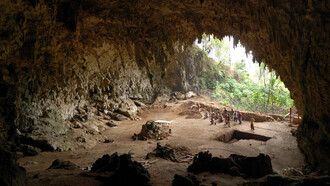The artist Teja Tegelj has a Master of Science in Art Pedagogy. This process of conceptual enquiry has a direct influence on the creative expression of her paintings. Through the process of drawing and painting she reflects on her gestures and recognises a balance between the emotional, physical force and the artistic mind. But this is not a solitary process, for Teja she is acutely aware of her audience. With art being a matter of imagination, she invites the viewer to not just observe the painting, but to step into it, to engage physically with it. Her exploration of this process is based on science. Latest neuroscientific research proves that imagining an activity creates a trigger within the same neural pathways as when the actual activity is performed. These mirror neurons also explore the notion of empathy, and therefore Teja would like her audience to step away from technological reproductions and digital art and revert to responding to art on a purely sensory level. This is especially poignant in current society where the frivolity of consuming numerous digital images, means that an artwork can sometimes only receive a passing glance from a viewer.
Teja’s personal path to date has influenced this current awareness. Her studies have led her to believe that creators from historical native cultures had great knowledge and understanding and that we, today, are lost in the modern world with substance of learning lacking. This belief is balanced with appreciation for more modern creators such as Mark Rothko, whose work Teja feels she can easily step into. Also, Auguste Rodin’s sculptures that are steeped in emotion and passion and Constantin Brancusi, who touches on unconscious patterns that we all have in common.
This commonality again feeds into Teja’s own work and is based on a celebration of the fact that all humans are linked, and all are integrated into and from nature. Within nature you find laws, order and patterns that are reproduced within humanity and it is this oft invisible world that inspires Teja. By paying attention to the relationship between positive and negative spaces she explores the idea that everything that surrounds us is negative, and is changing continuously. A concept that means that we leave traces of our presence in space even when we've physically left it. This is quantified by the fact that everything is moving and changing in nature: a constant metamorphosis. The invisibility of which are not traceable by a human’s five senses, however Teja recognises they are there and works to capture this within her paintings. And it doesn’t stop with the natural world:
“It is similar with human relationships. I am grateful to all individuals with who I established intimate relationship, as all the beauty, tension, passion and pain I received from them, expanded the spectrum of my perception.”
The response of an individual to art and how society has meant that many people were raised to act and think inside of ‘known’ structures, patterns and schemes contributes to Teja’s desire to engage with her audience. The significance of encouraging creative, divergent thinking on all levels of life is what she wishes to emphasise. But there is another aspect too: by offering variations and possible alternative facts within a work of art enables the viewer to make an independent and individual decision and response to it.
This desire to want people to be present, to pay attention links back to Teja’s awareness of the fragility and frivolity of the human within this so-called digital era. Questions arise of what happens when we try to get close to digital images: the answer being that due to the pixilation you run into a wall of coloured digital squares. Within Teja’s interactive works she challenges this pixilation and plays with the blurred borders between an image broken into square fragments and the classical visual form. The difference between the digital world and a world of live experiences.
Today we live in a diverse environment, abundance and saturation of visual stimuli often leads to disinterest and a lack of concentration that feeds through to the appreciation of 'fine art'. Teja asks herself how could contemporary art work, built on traditional mediums, not just hold the view of a person, but invite and integrate them into the process of a live experience. All On Right Place, Meditation In Blue, Sunset Through My Favourite Window and By The River Unica all require direct contact from the viewer that triggers a two-way conversation. When the audience gets to physically touch an artwork, they leave their distinct mark on it and naturally the next person continues the process: a relay of creation. This way communication and unity runs through all that are involved in this form-making activity.
Teja’s recognition of her own role within this process leaves impressions within her paintings of her own experiences, whether visual, auditory or tactile. This aspect of theoretical contemplation and free expression of feelings is allowed through her personal creative process and she embraces this alongside the reality it creates. A reflection of the treasure trove that is the world: a creative circle of life.
Teja Tegelj is a member of the Slovenian Association of Fine Arts Societies and an artist member of WITP Art Organisation that enables artists to exhibit without compromise to their artistic exploration and development.
www.teja-tegelj.com















